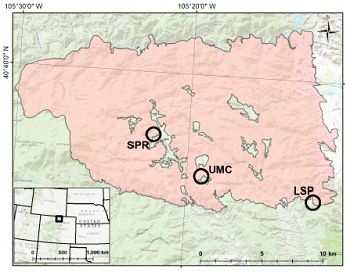Lybrand et al., 2018
Disturbance Alters the Relative Importance of Topographic and Biogeochemical Controls on Microbial Activity in Temperate Montane Forests
Lybrand R.A., Gallery R.E., Trahan N.A., Moore D.J.P. (2018)
Forests 9(2): 97
-
Calhoun, Catalina-Jemez, COLLABORATOR
-
Catalina-Jemez, INVESTIGATOR
Abstract
A map of the study area in Larimer County, CO, USA. The area burned by the 2012 wildfire is shaded red. Fifty-six study plots were established across the three study locations Stove Prairie Ranch (SPR), Buckhorn United Methodist Camp (UMC) and, Lory State Park (LSP) indicated with black circles. Inset map: the open black square contains the area of Colorado depicted by the main.
Fire and pathogen-induced tree mortality are the two dominant forms of disturbance in Western U.S. montane forests. We investigated the consequences of both disturbance types on the controls of microbial activity in soils from 56 plots across a topographic gradient one year after the 2012 High Park wildfire in Colorado. Topsoil biogeochemistry, soil CO2 efflux, potential exoenzyme activities, and microbial biomass were quantified in plots that experienced fire disturbance, beetle disturbance, or both fire and beetle disturbance, and in plots where there was no recent evidence of disturbance. Soil CO2 efflux, N-, and P-degrading exoenzyme activities in undisturbed plots were positively correlated with soil moisture, estimated from a topographic wetness index; coefficient of determinations ranged from 0.5 to 0.65. Conversely, the same estimates of microbial activities from fire-disturbed and beetle-disturbed soils showed little correspondence to topographically inferred wetness, but demonstrated mostly negative relationships with soil pH (fire only) and mostly positive relationships with DOC/TDN (dissolved organic carbon/total dissolved nitrogen) ratios for both disturbance types. The coefficient of determination for regressions of microbial activity with soil pH and DOC/TDN reached 0.8 and 0.63 in fire- and beetle-disturbed forests, respectively. Drivers of soil microbial activity change as a function of disturbance type, suggesting simple mathematical models are insufficient in capturing the impact of disturbance in forests.
Citation
Lybrand R.A., Gallery R.E., Trahan N.A., Moore D.J.P. (2018): Disturbance Alters the Relative Importance of Topographic and Biogeochemical Controls on Microbial Activity in Temperate Montane Forests. Forests 9(2): 97. DOI: 10.3390/f9020097
 This Paper/Book acknowledges NSF CZO grant support.
This Paper/Book acknowledges NSF CZO grant support.
Explore Further



